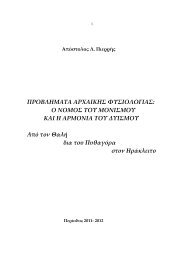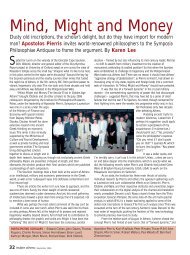chapter 10 the monism of darkness and the dualism of limit and ...
chapter 10 the monism of darkness and the dualism of limit and ...
chapter 10 the monism of darkness and the dualism of limit and ...
You also want an ePaper? Increase the reach of your titles
YUMPU automatically turns print PDFs into web optimized ePapers that Google loves.
94 CHAPTER <strong>10</strong><br />
because <strong>of</strong> which Cronos is absent from his position in <strong>the</strong> sequence,<br />
<strong>the</strong>n <strong>the</strong>re is an inexplicable confusion in Alex<strong>and</strong>er’s scheme. A fusion<br />
<strong>of</strong> two distinct Orphic traditions (<strong>the</strong> older archaic-classical <strong>and</strong> <strong>the</strong><br />
hellenistic-Rhapsodic) properly interpreted suffices to clarify <strong>the</strong><br />
problem.<br />
Order -1 0 1 2 3 4 5 6<br />
Old Orphism - Night Ocean (Egg) Phanes Heaven Cronos Zeus Dionysus<br />
Rhapsodic Time Ae<strong>the</strong>r (Egg) Night Heaven Cronos Zeus Dionysus<br />
Orphism Chaos Phanes<br />
Alex<strong>and</strong>er - Chaos Ocean Night Heaven Zeus <br />
<strong>of</strong> Aphrodisias<br />
(numbers indicate sequence <strong>of</strong> kingdom <strong>and</strong> generation)<br />
Members 3-6 are all common. To position 2 Alex<strong>and</strong>er assigns <strong>the</strong><br />
Night <strong>of</strong> <strong>the</strong> Sacred Doctrines. As to 0 <strong>and</strong> 1 he follows <strong>the</strong> Archaic<br />
sequence with <strong>the</strong> difference that having used <strong>the</strong> Night in her<br />
Rhapsodic position <strong>and</strong> function he substitutes, for <strong>the</strong> first principle<br />
Nyx <strong>of</strong> early Orphic doctrine, Chaos as <strong>the</strong> ontological equivalent<br />
which in fact partially (but extrinsically as remarked above) overlaps<br />
with <strong>the</strong> level <strong>of</strong> first principle (<strong>of</strong> beginning) in <strong>the</strong> Rhapsodic<br />
Theogony. From this mixture ano<strong>the</strong>r paradox can be best explained,<br />
namely that in an Orphic schema <strong>of</strong> <strong>the</strong> progression <strong>and</strong> production<br />
<strong>of</strong> reality Phanes (<strong>and</strong> <strong>the</strong> accompanying Egg) may be absent. Phanes<br />
<strong>and</strong> Egg being assigned to different stages <strong>of</strong> cosmic procession in <strong>the</strong><br />
two Orphic patterns, Alex<strong>and</strong>er’s source, conflating both, omitted<br />
incompetently <strong>the</strong> most characteristic Orphic feature (Cosmic Ovum<br />
<strong>and</strong> Primogenitus) from ei<strong>the</strong>r position in <strong>the</strong> sequence, adopting for<br />
each <strong>the</strong> o<strong>the</strong>r occupant in <strong>the</strong> two series, i.e. Ocean from ancient<br />
Orphism for place 1 <strong>and</strong> Night from Rhapsodic Orphism for place 2.<br />
17. Poetic awareness preserved in <strong>the</strong> purest form <strong>the</strong> original<br />
Orphic idea <strong>and</strong> experience that <strong>the</strong> Night as very first cosmogonic<br />
principle expresses <strong>the</strong> abyssmal Darkness <strong>of</strong> aboriginal Chaos. On <strong>the</strong>










